

Cultural considerations of play - Google Drive. Aboriginal Education Resources.
Courses - Brooklyn Institute for Social Research. Architecture & space. Games. Personalized Learning. A Transformational Vision for Education in the US 2015 09. Outcomes. SDG_2030. Helping Struggling Learners and Tools for Differentiation. Universal Design for Learning. School Retool - Videos. Students at the Center. Students at the Center. Next Generation Learning Challenges. This New 2-Year College Is Unlike Any Other. And That Could Be Its Biggest Challenge. Competency-Based Education.
Station Rotation Model: Grouping Strategies. The Station Rotation Model is a blended learning model where students rotate through a series of online and offline stations.
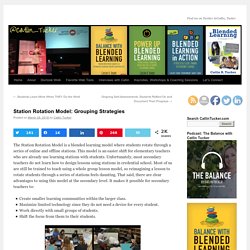
This model is an easier shift for elementary teachers who are already use learning stations with students. Unfortunately, most secondary teachers do not learn how to design lessons using stations in credential school. Most of us are still be trained to teach using a whole group lesson model, so reimagining a lesson to rotate students through a series of stations feels daunting. That said, there are clear advantages to using this model at the secondary level. It makes it possible for secondary teachers to:
SOLE Toolkit Web 2.6. SOLE Toolkit Web 2.6. School in the Cloud. StartSOLE - Let Learning Happen. 10 XQ Super Schools Announced: Leading the Way in Rethinking High School. The XQ team saw the massive opportunity to make a difference for every young person in America.
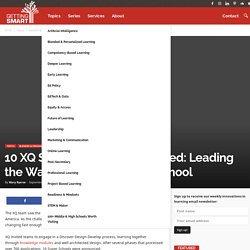
As the challenges in our world change faster than ever, too often our schools aren’t changing fast enough to help students meet those challenges. "OER: A Field Guide for Academic Librarians" by Andrew Wesolek, Jonathan Lashley et al. » New England. Inspiring Learning Everywhere. Collaborize Classroom Library. The Habitus of Critical Imagination. "whatever we do together is pure invention the maps they gave us were out of date" ~ Adrienne Rich, Poem VIII What follows is a keynote written for the TLTS event on Auraria Campus on October 5, 2018, meant as an introduction to a day of creative problem solving, and to my recent publication, An Urgency of Teachers.

I was invited to speak at this event, sponsored by Metropolitan State University in Denver—my alma mater—but for reasons out of my control, I was unable to attend. I was not meant to attend Metropolitan State College in Denver for my undergraduate degree. In 1989, I was accepted to Pacific University, a small private liberal arts college nestled in rural Forest Grove, Oregon. Participate. Dipsticks: Efficient Ways to Check for Understanding. What strategy can double student learning gains?

According to 250 empirical studies, the answer is formative assessment, defined by Bill Younglove as “the frequent, interactive checking of student progress and understanding in order to identify learning needs and adjust teaching appropriately.” Unlike summative assessment, which evaluates student learning according to a benchmark, formative assessment monitors student understanding so that kids are always aware of their academic strengths and learning gaps. It also helps teachers improve the effectiveness of their instruction. ReadWriteThink. Lesson Planning. Smart List: 100 Middle and High Schools Worth Visiting. School visits are a great way to learn.
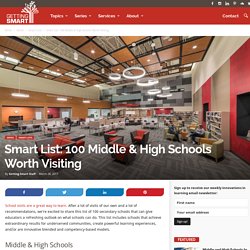
After a lot of visits of our own and a lot of recommendations, we’re excited to share this list of 100 secondary schools that can give educators a refreshing outlook on what schools can do. This list includes schools that achieve extraordinary results for underserved communities, create powerful learning experiences, and/or are innovative blended and competency-based models. Middle & High Schools 1. Partnerships with business leaders. What if we tested schools the way chefs test new restaurants? – Medium. I am obsessed with this question — HOW do we create next generation schools?
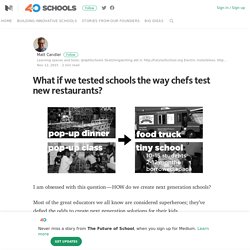
Most of the great educators we all know are considered superheroes; they’ve defied the odds to create next generation solutions for their kids. But what if we could change the ODDS? What if next generation schools were the norm, not the exception? Well, I’ve found inspiration in a place I’ve always loved to explore but never thought I could write off to R and D — in food! Trying new recipes on other people and cooking on wheels are nothing new, but using pop-ups and food trucks strategically — to test new restaurant ideas — has transformed the entire restaurant industry.
The Worlds Largest Lesson. Penn GSE AHEAD - College Promise Programs. With financial support from Civic Nation, this project is designed to advance research-based understanding of College Promise programs in the United States.

What is a College Promise program? Over the last decade—but especially in the past few years—programs with the "promise" label have been advanced at local, state, and federal levels. These programs are designed to increase college attainment in particular places. The Kalamazoo Promise program, created in 2005, inspired similar programs in economically disadvantaged communities in Michigan and other states. The Do’s and Don’ts of Bringing Personalized Learning Into Rural Schools. Edsurge. There are many building blocks that make up a school. The schedule, budget, infrastructure, school culture and the learning environment represent just a handful. Each element has a tremendous impact on the learning experience for students, staff and families. These blocks can be organized and reorganized in any number of combinations.
The way they are put together defines the model of a school. All over the country, schools regularly experiment with rearranging, reshaping or redesigning these pieces to make school more engaging and personal for students and teachers. Across the country, we see examples of these experiments, big and small, that inspire us to think about what’s possible in schools. But rethinking schools is hard; changing one building block can shift the entire structure, and always poses challenges.
Design Thinking for Education: Student-Centered Learning. In addition to grounding their innovations in learning science and educational research, NGLC grant recipients are borrowing strategies from entrepreneurs, tech start-ups, Makerspace, and human-centered designers.
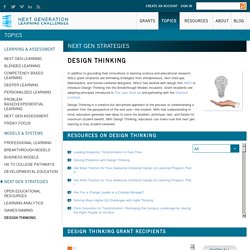
NGLC has worked with design firm IDEO to introduce Design Thinking into the Breakthrough Models Incubator. Grant recipients are adopting principles introduced in The Lean Start-Up and partnering with the Stanford d.school. Design Thinking is a creative but disciplined approach to the process of understanding a problem from the perspective of the end user—the student. With that understanding in mind, educators generate new ideas to solve the problem, prototype, test, and iterate for maximum student benefit. Architecture’s Pivotal Role in the Future of K 12 Learning. School buildings and their learning environments have remained relatively static over time.
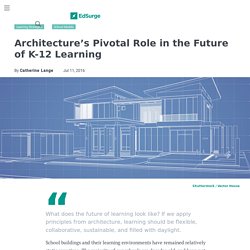
The majority of our schools are decades old, and have not undergone a major redesign since they were originally built. These classrooms were built for traditional, “chalk-n-talk” modalities and passive learning—they are not prepared for today’s more active learning approaches. The United States has over $2 trillion invested in its school buildings, the majority of which were designed as "cells and bells. " Cells are the classrooms students inhabit until the bell rings, at which point they move on to another cell. This model for schools has been prevalent for over a century, finding its roots in the Industrial Revolution and large-scale manufacturing ideals. Samaschool. The 13 most innovative schools in the world. Innovation in education can look like lots of things, like incorporating new technology or teaching methods, going on field trips, rejecting social norms, partnering with the local community.
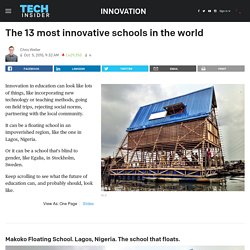
It can be a floating school in an impoverished region, like the one in Lagos, Nigeria.
Aging Societies Should Make More of Mentorship. The past year brought a rich array of films depicting connections between a wise, older mentor and a younger person in need of sage guidance, in ways that often defied gauzy stereotypes, from art-house movies like Lily Tomlin’s Grandma to blockbusters like Star Wars: The Force Awakens. In Creed, Sylvester Stallone serves as a contrarian mentor and coach to the son of his deceased friend and former boxing rival, while The Intern pairs entrepreneur Anne Hathaway with former Raging Bull Robert DeNiro as the eponymous intern. Free, high-performing public charter schools in Cleveland, Ohio.
2015144. Online Learning Resources. Annual Survey of Learning Tools. LMS. Homeschool. Resources. Kids & Computers. Ed Theory.